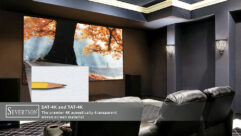

3D, Coming to a Conference Room
Is 3D video for real, or is it a fad? Does it really have any place in corporate AV? Perhaps. 3D may be all the rage at the movies and, eventually, in the home. But interestingly, pro AV markets are set up nicely for 3D adoption. Parallax View columnist Pete Putman explains why.
Demos have also been done using plasma displays, which by nature are fast enough to sequence left eye/right eye information for active-shutter viewing. And in the LCD camp, we’ve seen glassless 3D demos using specialized front-surface polarizing glass (more of a novelty than a practical 3D solution, from my perspective), as well as conventional 3D sequencing using a 240-Hz picture refresh rate.
If there is one trend in display technology that has captivated the public’s attention, it’s 3D imaging. More and more animated movies are being released in 3D, and there’s plenty of convincing proof that 3D versions generate more box office receipts than conventional, “flat” 2D prints and digital releases. 3D is coming to television, too, albeit not as quickly.
During the 2009 Super Bowl, viewers who wore anaglyph glasses could watch a 3D trailer for the animated feature Monsters vs. Aliens and a 3D commercial for Pepsi’s SoBe energy water. The 3D effect was erratic and primitive, but it worked at times. (NBC followed up the next night with an episode of Chuck in 3D, also using anaglyph coding.)It gets better. YouTube is currently testing anaglyph 3D videos on its website and apparently hopes to make them a regular feature. And there are already consumer HDTVs and projectors that can work with more sophisticated active-shutter stereoscopic glasses, using Texas Instrument’s digital light processing chips.
Pete Putnam, CTS, ISF
In short, 3D has captured a disproportionate share of the spotlight lately. And it was no surprise to see 3D featured prominently in several booths at InfoComm 09, most notably in DLP projector demonstrations using TI’s DLP Link synchronization technology.The abundance of 3D imaging products and demos at InfoComm 09 caught many analysts and reporters by surprise. So did prices for the technology. One industry veteran actually told me that the prices for 3D-equipped DLP classroom projectors were too low, and he suspected TI and its partner manufacturers were trying to jump-start 3D business instead of supporting the higher profit margins that 3D products should expect and realize.
So is 3D for real, or is it a fad? Does it really have any place in our industry? A growing number of industry groups seem to think 3D will become pervasive in a short time. The Society of Motion Picture and Television Engineers (SMPTE) formed a working group to research delivery of 3D and issued a report of its findings in April. 3D was also a big topic at the National Association of Broadcasters’ Digital Cinema Summit. And the TI DLP Link demos at InfoComm showed that affordable classroom projectors could be adapted for 3D projection with minimal added cost.
In fact, though there are obstacles to 3D viewing at home, such as inconsistency in viewing distances, viewing angles, and screen sizes, those obstacles aren’t as problematic in a classroom or lecture hall that’s already been designed for optimal 2D viewing. And the possibilities in the pro space are endless, from 3D views of the human body for anatomy classes to exploded views of machinery and engines, the solar system, geophysical features, chemical compounds, you name it. If it can be rendered in 3D, rotated, turned, and enlarged, it’s a candidate for 3D imaging.
Selling 3D
Can dealers and integrators sell 3D to their customers? Aside from the usual “I saw it in a theater, so I want it at home” requests, there’s a good case to be made for 3D-ready enterprise installations, particularly in any kind of education environment. That means your current customers should look into their crystal balls and see if 3D would make sense for them down the road before you start specifying equipment. Why? Because not all display technologies handle 3D imaging with equal aplomb.
3D, Coming to a Conference Room
Is 3D video for real, or is it a fad? Does it really have any place in corporate AV? Perhaps. 3D may be all the rage at the movies and, eventually, in the home. But interestingly, pro AV markets are set up nicely for 3D adoption. Parallax View columnist Pete Putman explains why.
It’s a certain bet that most 3D projector installations will rely on active-shutter technology. A single projector switches at high enough speeds to sequence the left-eye and right-eye information, making stacking unnecessary and providing the best spatial separation with minimal crosstalk. At present, the only regular demos I’ve seen of 3D projection have used DLP projectors, using both single-chip and three-chip light engines. DMDs can switch at extremely high speeds with no image retention problems; so active shutter 3D is a walk in the park for them.
How about LCoS and 3LCD? I have seen 3D demos on D-ILA projection systems, but nothing featuring 3LCD technology just yet. In theory, both systems should be able to handle 120-Hz refresh rates, making them compatible with active shutter glasses. In practice, the question is how much blur and image persistence would actually occur.In the flat-panel arena, the best 3D demos have relied on plasma technology. Panasonic showed live 3D imaging on a 103-inch PDP in its NAB Show booth. Samsung has also demonstrated a variety of 3D clips from video games, animation, and live HD footage. LCD monitors, however, have it tougher.
Faster refresh rates aren’t a real problem for LCD, particularly with LED backlights now coming to market. LEDs can switch hundreds of times per second without breathing hard, but that extra speed is currently put to use eliminating the motion blur artifacts seen on conventional LCD displays. Whatever refresh rate is optimal for minimal blurring must then be doubled to sequence the left-eye/right-eye information. 120-Hz isn’t quite fast enough to sharpen motion blur. The best hope currently for 3D on LCD displays would be a 240-Hz system doubled to 480 Hz-a system that would have to rely on LEDs at such speeds.
Despite all the qualifiers, 3D has arrived. The question is, how fast will our industry adopt it, and for which vertical markets? I’m betting education will be first out of the gate, using primarily front- and rear-projection installations. But ultimately AV pros are on the front lines of adoption. So what are you seeing?
Pete Putman is a PRO AV contributing editor and president of ROAM Consulting in Doylestown, Pa.










